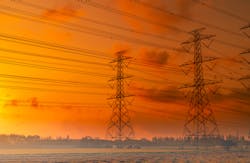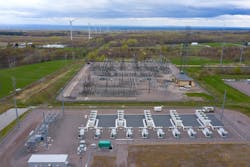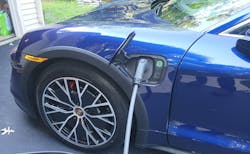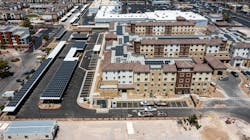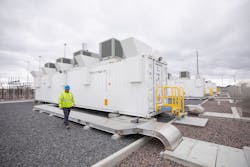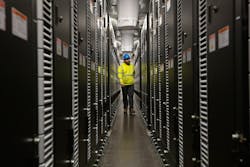By 2035, the Biden-Harris Administration strives to achieve 100% clean electricity. To meet the country’s growing demands for clean energy and resiliency, transmission systems will need to expand 60% by 2030 — and may even need to triple by 2050, according to independent estimates shared by the Department of Energy (DOE). Today’s electric utilities are powering electric vehicle (EV) charging stations, launching renewable energy and storage projects, expanding transmission capacity, and modernizing aging infrastructure. To help the nation meet these goals, electric utilities and contractors are paving the way to a greener future.
Greg Darkenwald, president of Capital Electric Line Builders, expects to see continued growth in all sectors of the transmission, distribution, and substation markets.
“Our utility customers have steadily grown their operations over the last five to 10 years to meet continually increasing demand,” Darkenwald says. “While we don’t have visibility to their funding sources for their work, we expect to see continued growth for the foreseeable future.”
In the electric utility industry, federal funding is continuing to drive growth, especially in those markets related to transmission expansion and EV charging infrastructure. By 2030, the Biden-Harris Administration has set the goal of building a national network of 500,000 public EV charging stations and reducing greenhouse gas emissions by 50% to 52% below 2005 levels.
To support the EV industry, the Bipartisan Infrastructure Law (BIL) will invest $7.5 billion in EV charging, $10 billion in clean transportation, and more than $7 billion in EV battery components, critical minerals, and materials, according to WhiteHouse.gov. The Inflation Reduction Act (IRA) is investing in clean energy jobs and resources to improve access to EV and charging infrastructure.
According to EC&M’s 2023 Top 50 Electrical Contractors, EV charging is getting the biggest boost from federal infrastructure funds when it comes to projects they’re working on, followed by renewable installations and electrical grid updates. Here’s a look at each of these market opportunities for contractors.
Charging the future
In March 2023, the Administration opened applications for a new multi-billion-dollar program to fund EV charging and alternative-fueling infrastructure nationwide. While utilities are partnering with companies across the country to install the charging stations, this infrastructure is especially sought after in California — where more than 500,000 EVs have been sold in Pacific Gas & Electric’s (PG&E’s) service territory, representing one in seven EVs in the country.
After California Governor Gavin Newsom signed an executive order stating that by 2030, all new passenger cars, trucks, and SUVs sold in the state must be zero-emission vehicles, PG&E launched a program to offer no-cost charging infrastructure and resources to underserved communities. Oftentimes, EV adoption may be low in these areas due to high upfront vehicle costs and inadequate access to public charging stations.
“We serve a diverse population and want to ensure all of our customers have the resources they need to make EV ownership an attainable goal,” says Jason Glickman, PG&E executive vice president of engineering, planning, and strategy. “These new programs align with our core focus to support EV adoption, proactively prepare the grid for the future, and increase access to charging infrastructure.”
Through the Empower EV program, PG&E is offering a free Level 2 charger (valued at $500) to about 2,000 eligible customers. In addition, the utility will cover up to $2,000 per eligible household for panel upgrades by the program’s approved electrician.
California is not the only state investing in EV charging infrastructure and providing new revenue streams for electricians. For example, in the Washington D.C. metropolitan area, Master Electrician Dennis McDade, CEO of A Plus Electric, is helping his customers charge their electric vehicles at home.
The electrical company, which is based out of Northern Virginia, provides residential services to customers in Virginia, Maryland, and Washington, D.C. Recently, the contractor has focused on installing Level 2 electric vehicle charging stations in residential homes in its licensing areas. The chargers offer a higher power output and use a 240V outlet similar to clothes dryers or air conditioners, and they can be installed in residential or commercial settings.
“With the current mass production of electric vehicles, there’s a high demand for residential charging stations in the DMV area,” McDade says. “A Plus Electric has accepted this opportunity to provide customers with clean, efficient, and reliable charging stations in their homes. With several hundred charging stations installed so far in 2023, we expect to triple the number of installations in the upcoming fiscal year.”
To take advantage of the EV charging market, electricians can enroll in certification programs from the charging station companies, McDade says. By obtaining his master electrician’s license, however, McDade says he received thorough training in the planning and installation of EV charging stations per the National Electrical Code standard.
Generating and storing renewable energy
Beyond installing EV charging infrastructure, electrical contractors are also embracing opportunities in the renewable energy markets. To handle the increased workload, many utilities are partnering with contractors with renewable energy divisions. Through this collaboration, utilities are striving to increase power reliability, efficiency, and resiliency. For example, MDU Construction Services Group (CSG), one of EC&M’s Top 50 Electrical Contractors, owns a subsidiary named Bombard Electric, an IBEW Local #357 electrical contractor with a division called Bombard Renewable Energy. The company was recently named one of the top solar contractors in the nation by Solar Power magazine.
Since the electrical contractor launched Bombard Renewable Energy nearly 20 years ago to meet Nevada’s demand for green energy, its team has installed more than 800MW of solar photovoltaic energy across Nevada. As part of its business, the company has not only specialized in commercial, industrial, government, low-income, and nonprofit work, but it has also taken on utility-scale renewable energy projects to provide energy off the grid, produce electricity on tribal lands, and offer renewable electricity options to utility customers. For example, Bombard installed 1.9 million modules and 48 inverters for a ground-mount utility-scale solar installation in Clark County, Nev.
On the transmission and distribution side of the renewable sector, MDU CSG’s operating companies are building wind farm collector systems, substations, and transmission lines. The electrical construction companies complement that work by building commercial and utility-scale solar PV systems, EV charging stations, and battery energy storage systems.
In the electric utility industry, energy storage can help to enable renewable energy growth and relieve transmission constraints. For example, in New York, the New York Power Authority (NYPA) just began operating a utility-scale energy storage system. The 20MW facility, which is owned and operated by the NYPA, connects to the state’s electrical grid.
Five 53-foot walk-in enclosures include more than 19,500 batteries grouped in modules and stacked in racks. Each container can disperse 4MW of power — enough to power about 3,000 homes, according to the NYPA. In addition, the system includes inverters, transformers, a control house, and a back-up generator, which are all connected to a nearby substation.
O’Connell Electric Company of Victor, N.Y. constructed the project, which provides 20MW of power using a lithium-ion battery system. As the general contractor for the design-build contract, O’Connell managed both the engineering and construction of the battery system and supported the interconnect equipment, says Lynne Smith, media relations for the NYPA.
In Arizona, Salt River Project (SRP) is supplementing other storage options on its system with a new long-duration energy storage project called Desert Blume. The non-lithium technology can deliver 5MW of power for at 10 hours per cycle.
The pilot project is the third phase of a project at Cooper Crossing Energy and Research Center. The first two phases include the addition of two flexible natural gas turbines and a utility-scale advanced solar generation facility capable of generating up to
55MW of solar energy.
SRP is partnering with CMBlu Energy on the project, which aims to store energy for SRP’s customers, mostly derived from solar power, and return the energy to the grid throughout the night. According to SRP, it will store enough energy to power 1,125 average homes for 10 hours.
“This resource will supplement SRP’s power system helping provide stored power for longer periods, especially in times of fluctuating, high energy demand from customers in the Valley,” says Jim Pratt, CEO of SRP. “It will be a helpful addition to SRP’s significant number of renewable resources and storage projects, which generally only store energy for up to four hours.”
Modernizing infrastructure
Electric utilities are not only launching utility-scale renewable energy and storage projects to provide clean, green electricity to their customers, but they are also focusing on constructing new transmission lines to support these projects.
ecently, the U.S. DOE announced $300 million for Transmission Siting and Economic Development, which was established as part of the IRA. States, tribes, and local governments can now apply for grants to accelerate and strengthen electric transmission permitting and siting processes. The funding is designed to overcome state and local challenges by expanding transmission capacity while supporting communities with new and upgraded lines. Accelerated transmission line development is critical to meet the country’s growing clean electricity and resiliency demands, states the DOE.
Along with building new transmission lines, electric utilities are also challenged with upgrading aging infrastructure throughout their service territories. For example, Darkenwald says Capital Electric Line Builders’ utility clients are implementing system integrity programs to replace aging transmission and distribution infrastructure.
“Our customers are enhancing the electrical grid through the addition of new facilities as well as rebuilding existing facilities to handle the capacity necessary to support this growth,” he says.
Capital Electric Line Builders is a subsidiary of MDU CSG Construction Services, which has been serving the power utility market since the company was founded in 1997 with the acquisition of a T&D contracting company. Since that time, MDU has acquired additional T&D companies with complementary services to meet customer demand across the company. The MDU CSG subsidiaries focused on the utility market provide all aspects of transmission and distribution construction services, including overhead and underground transmission and distribution and substations. In addition, they perform maintenance services for existing services as well as new construction.
“We’re proud to be part of the network of companies that help deliver safe, reliable power to consumers and businesses,” Darkenwald says.
Nationwide, electric utilities are continuously challenged with severe weather conditions, leading to tree strikes on power lines, toppled towers/poles, and downed lines. To stand up to storms and keep the lights on for their customers, electric utilities often partner with contractors to perform reconducting projects to replace existing cable with upgraded technology to improve reliability. Lineworkers are also undergrounding lines in areas at an elevated risk for wildfires or installing stronger, more resilient poles and wider crossarms to minimize power outages in high-wind conditions.
Lineworkers are also installing new technology on infrastructure and using the latest tools and techniques out in the field. To embrace emerging markets, electrical contractors working for utilities must train their field workforce. For Capital Electric Line Builders, the team is continually adapting to new technology such as tools, software, and techniques in all sectors. Darkenwald says education and training are an ongoing and vital commitment.
“Our operating companies share knowledge and collaborate daily, and we partner with our customers and subcontractors to maximize the benefits of technology on every project,” Darkenwald says. “We also work directly with companies creating new technology to train our teams.”
Looking to the future, Darkenwald says he’s proud to be a part of the grid modernization projects.
“Capital Electric Line Builders and its sister companies will continue to serve our customers, supporting the ever-growing demand for EV charging stations, T&D power, and fiber-optic/communications systems,” he says.
By staying in tune with technology and providing the proper training and resources, electrical contracting companies can help utilities to meet their clean energy goals and power America both today and in the future.
Amy Fischbach ([email protected]) is a freelance writer and editor based in Overland Park, Kan.
About the Author
Amy Fischbach
Amy Fischbach is a freelance writer, editor, and host of the Line Life Podcast based in Overland Park, Kan. Contact her at [email protected].
